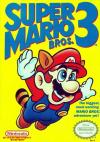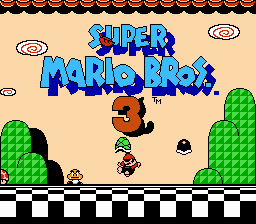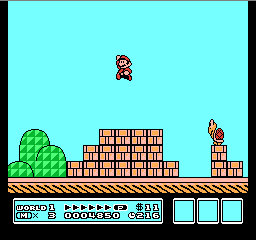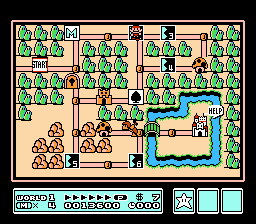Forum Links
Thread Information
Thread Actions
Order
Super Mario Bros 3: The Standard all Platform Games Abide by
Game's Ratings
Overall
Graphics
Sound
Addictiveness
Depth
Story
Difficulty
Average User Score
9.3
8.5
8.9
8.7
8.3
7.5
7.1
11-19-15 12:20 PM
SWTerra is Offline
| ID: 1220161 | 2461 Words
| ID: 1220161 | 2461 Words
SWTerra
Level: 55




POSTS: 165/741
POST EXP: 94504
LVL EXP: 1234871
CP: 3722.8
VIZ: 25756
POSTS: 165/741
POST EXP: 94504
LVL EXP: 1234871
CP: 3722.8
VIZ: 25756

Likes: 1 Dislikes: 0
EDIT: Whoops, for some reason the scores cleared out on the ratings. I've fixed that. From a completely unknown game, to the game just about everyone knows about, I take my reviewing lens here and focus it on an all-time classic, Super Mario Bros 3. == Overall == Super Mario Bros 3 has been universally acclaimed throughout its 25+ year history at this point, so there's really not too much for me to explain that isn't already known. However, I may as well explain a bit as precaution. Super Mario Bros 3 is the last of the trilogy of games released on the Nintendo Entertainment System (NES for short). It was released in 1989, after being shown in the feature film "The Wizard." Its hype and commercializing were obviously well-justified; even today, this game is seen as the greatest NES game ever made, and is still referenced in many ways. Its formula is also still used as a baseline in most platform games to this day. But what makes it so great? Note: I will once again avoid going over story in this review, although I will give a score for it, since technically there actually is story in here. There’s really no reason to go over the obvious story that encompasses almost all mainstream Mario games, being the simple “save the princess” cliché that it is, and if you’re looking at this game for story, then, quite frankly, you should look somewhere else. == Graphics: 10/10 == Super Mario Bros 3, right up there with the likes of Kirby's Adventure (a game that came out in 1990), had graphics that further defined the golden years of Nintendo. As far as the NES went, the graphics were the prime of its time. The detail and color of the sprites, the beautiful backgrounds, and the smart overall design less to one of the most beautiful games of its era, and clearly pushed the limits of the NES altogether, while still keeping the game itself from lagging (something that Kirby's Adventure was unable to avoid, although I can't speak for its performance on its Japanese counterpart, the Famicom (short for Family Computer) Disk System (as in Floppy Disks, not CDs), which is notably better than the NES).== Sound: 10/10 == Right next to the ground theme from the original Super Mario Bros four years prior, the athletic theme from Super Mario Bros 3 is probably one song most people immediately think of when they think Mario. The first Super Mario Bros is not the only Mario game with a memorable soundtrack. Especially in Japan, this new soundtrack and visual came out of nowhere, since their version of Super Mario Bros 2 (which was eventually released in America under the name "Super Mario Bros: The Lost Levels) had the exact same soundtrack (and similar visuals) as the first. Super Mario Bros 3 took the soundtrack of the original in the trilogy, and expanded upon it tenfold. There are more overall VGM tracks, smoother instruments, and more specific music tracks as a whole. All in all, it’s a heavy upgrade for the final game of the SMB trilogy.== Addictiveness: 9/10 == The magnificent control over your character. The detailed and unique level design. The expansive list of power ups. There are so many reasons to give this game a perfect ten in addictiveness, but it’s hard to choose which is the most important!The game’s control is easily one of the biggest draws to this game, as well as one of the biggest reasons that gamers old and new return to this game time and time again. This game is the poster boy of platform game physics done right. They are not the most “realistic,” but this is one genre that I prefer has some leniency in its physics. Leave the realistic stuff to first person shooters and Kerbal Space Program, please (because that’s obviously the ideal example of nothing but realism). Allow me to elaborate on the physics to your control. Mario has a slight float to his jumps, and a great control over his inertia, both on the ground and in the air. While I, myself, tend to not like floaty physics in a game, I can’t deny that it helps the game, overall, especially since the platforming, at times, can actually be rather challenging and frustrating, if you didn’t get that extra second to re-adjust yourself while making a jump. It makes for leeway against miscalculated bounds, and gives its own little reward to those who may play more casually and take the game at a slower pace. At the same time, playing through this game quickly significantly lowers your leeway for jumps, even with the added floatiness, allowing the game to still be hard to go through at a relatively quick pace. This touch of floatiness adds to the ease of slow play, and also does little to hinder the difficulty of faster-paced play. The level design was done very well, and was organized even better. The different themes of each world (Grass Land, Desert Land, Water Land, Giant Land, Sky Land, Ice Land, Pipe Land, and Dark Land) were apparent in the level design in very obvious ways, although their names took a dose of Mega Man syndrome (all robot masters were just named The power up list got a much needed upgrade, after the first two Mario games (not counting the USA Super Mario Bros 2) only had the Super Mushroom, Fire Flower, Star Man, and infamous Poison Mushroom (a hint to its infamy: it doesn’t give you poison powers). These are the new power ups: The Raccoon/Tanooki Suit (the Tanooki Suit is a slightly upgraded version of the Raccoon Suit with the ability to turn into an invulnerable statue) gives you the ability of flight, if you accelerate to full speed while running. The Frog Suit, still exclusive to this game (the modern-day equivalent/upgrade would be the Penguin suit), gives you a significant boost while swimming, but is of practically negative use above water. However, beat an airship while wearing this suit, and you may get a special reward… The Hammer Bro Suit, arguably the second most overpowering ability in Mario history below the cape from Super Mario World, allows you to throw arcing hammers that kill almost anything. The invulnerable Boos? More like, no match for hammers. However, the overpowering nature of the Hammer Bro Suit is actually well-deserved, unlike the cape from Super Mario World, as it is a very rare suit, only obtainable in a few The P-Wing, a level-breaking upgrade of the Raccoon Suit, can be considered one of the first “super-guide” power ups in gaming, and the first in the Mario series. While not invulnerable, it still grants unlimited flight in a single level, before reverting to a regular Raccoon Suit. It is most notably used by many players in a certain Desert Land level, where the sun itself chases after you. More experienced players may instead prefer to save it for Sky Land, or even a level in Dark Land near the end. All of these power ups give a huge boost to gameplay addictiveness and depth, which is something I’ll be going over in short coming up. Ultimately, the only weakness the game has (and the reason that I give this game a 9/10 in addictiveness) is mostly hardware-related. While future remakes fixed this glaring issue, this review is focusing on the original classic. I tend to not let hardware limitations affect my scoring of a game, but this is too much of a problem to pass up: no save feature. Yes, I realize how limited the NES was in that field, and the fact that you have memory with numbers of different possibilities (referring to stages cleared in a world (including all mushroom houses and card games), extra item slot places (can be up to 10 different items per slot (including empty), which leads to an insane amount of combinations), and cards attained (mushroom, flower, star)) made even a password system sound like a very cumbersome addition. The likes of Metroid’s password system is far simpler than would be needed in the case of Super Mario Bros 3. Regardless of such, I have to acknowledge it as a huge problem in a rather expansive game on the NES. This game is one of the overall most expansive games on the NES, and that’s without a doubt. But the question about this game’s depth was how to make it enjoyable, fun depth, especially on a game lacking a save feature. And that came and shined in the way of varying level design that was heavily dependent on the world the level was in. Every level, aside from Grass Land, had something unique to the levels that existed in each one: Desert Land has quicksand and fire snakes, and has almost no platforming perils; instead, the peril is more in the rather smart enemy placement. Water Land is very infamous for being the near-obligatory water level in a platform game, and Big Bass, especially in Level 3-8. Giant Land literally supersizes everything. There’s nothing overly challenging about this world as a whole, but the concept itself was funny and enjoyable. Sky Land is notorious for some balls to the wall type difficulty spikes in platforming. What did you expect, landing room? You’re in the freaking sky; you’d better hope you’ve kept a raccoon transformation or two! Chances are, you’ll need it. Ice Land is…well…ice. Need I explain any more than that? Slippery physics, troubling momentum control, and general frustration, especially for the first-time player. It’s clear that the difficulty goes up naturally, minus some levels in Sky Land. Pipe Land is the only world in which dying by losing time is actually understandable; after all, the entire world is a collection of labyrinths! There’s obviously no shortage of pipes here, and even the overworld theme is slow, lax, and boring. Dark Land almost completely forgoes platforming for the first half of this world, much like the airships at the end of each world. In fact, this world is the only one with non-airship vehicle autoscroll levels, and these were done very well. This world becomes less about platforming, and more about avoiding the onslaught of enemies presented to you. This will test your ability to quickly dispatch difficult enemies (including a number of hammer, fire, and boomerang bros) on your way to the goal, the same way Sky Land and Ice Land tested your ability to master precise jumping and momentum control. These slight differences between each theme actually offer a bit in terms of depth, and keeping that depth fun and interesting. They keep the levels from becoming too repetitive, and, as such, are more than welcomed as a result, even if the differing themes can, at times, cause difficulty spikes within the game, specifically when transitioning from one world to the next, which is a minute problem with the world themes system that I will gladly take for the benefit it brings. Ultimately, this is the biggest benefit to depth that this game has. Depth isn't only about mindlessly lengthening the game, and it's clear that Nintendo knew this as well as anyone would. Super Mario Bros 3 had a very good grasp on the concept of balance in difficulty. There was never a portion of the game that felt overwhelmingly difficult, and, besides Grass Land, the first world, there was never a time where I felt like the game was holding my hand. It was difficult at times, but not too difficult. It was easy at times, but not too easy. The biggest downside in Super Mario Bros 3’s difficulty is something I had just finished mentioning: occasional difficulty spikes and drops. Giant Land has a sudden drop in difficulty, with more spread-out enemy placement and the greater size of these enemies actually making them easier to deal with than their normal-sized counterparts. The platforming is also significantly easier than many other worlds, and it’s overall an undeserved drop in difficulty in the middle of the game. However, Sky Land, the very next world, dynamically changes the difficulty and spikes it rather high during the latter half of the world (the first half of the world takes place in the ground). The platforming is notoriously some of the toughest in the entire game, and this is only in the middle of the game! This sudden lack of balance in difficulty is a glaring problem in such a linear game. There’s no way to avoid these sections (not including secrets that allow you to skip worlds), so you HAVE to play through these uneven difficulty portions. It’s a big blow when the difficulty doesn’t rise gradually with your experience in the game. This game, at its core, is no different from its predecessors in Japan (Super Mario Bros 2 in the US is a different story, though). However, it didn’t have to be. Nintendo knew this much, even back then. They just knew it had to be fun. They knew it would sell, and it did. This is a game you absolutely shouldn’t miss out on if you’re any fan of Mario or platform games. It set many precedents for Mario games, and platform games as a whole, moving forward, and is still one of the standards that platform games are compared against. If that doesn't say much to you, then I don't know what will. |
Trusted Member
Affected by 'Laziness Syndrome'
Registered: 10-10-15
Location: USA
Last Post: 3448 days
Last Active: 1254 days
| I'm just an aspiring hobbyist reviewer and writer who likes to talk way too much. |
Affected by 'Laziness Syndrome'
Registered: 10-10-15
Location: USA
Last Post: 3448 days
Last Active: 1254 days
(edited by SWTerra on 11-23-15 09:47 AM) Post Rating: 1 Liked By: Eirinn,
11-23-15 02:34 AM
Eirinn is Offline
| ID: 1220797 | 95 Words
| ID: 1220797 | 95 Words
Eirinn
Level: 157





POSTS: 5047/7900
POST EXP: 1300417
LVL EXP: 49283361
CP: 69417.5
VIZ: 1839871

POSTS: 5047/7900
POST EXP: 1300417
LVL EXP: 49283361
CP: 69417.5
VIZ: 1839871

Likes: 0 Dislikes: 0
Good review. It breaks down every aspect of the game in a very detailed way. It's long, but the way it's written makes that okay. You showed that you really knew this game quite well, even better than most really. It really is one of the greats even still, and with good reason. Also, bonus points for the "This game is the poster boy of Nintendo’s dominance of the 8-bit market, not through gimmicks or brand new, unique changes, but through pure, solid games, colorful graphics, crisp sound, and deep, fun gameplay." part. So true. |
Vizzed Elite
Affected by 'Laziness Syndrome'
Registered: 07-18-12
Last Post: 2687 days
Last Active: 2687 days
| Eirinn |
Affected by 'Laziness Syndrome'
Registered: 07-18-12
Last Post: 2687 days
Last Active: 2687 days
11-23-15 09:53 AM
SWTerra is Offline
| ID: 1220838 | 72 Words
| ID: 1220838 | 72 Words
SWTerra
Level: 55




POSTS: 171/741
POST EXP: 94504
LVL EXP: 1234871
CP: 3722.8
VIZ: 25756
POSTS: 171/741
POST EXP: 94504
LVL EXP: 1234871
CP: 3722.8
VIZ: 25756

Likes: 0 Dislikes: 0
Eirinn : Thanks! Yeah, I realized it was a bit long, but I guess you tend to get long-winded with a review of a game you've known and loved since being a little kid, haha. You tend to remember a lot about the game. At least you were okay with how I broke it down. Would you be okay with being summoned for my other reviews from here on out, by the way? |
Trusted Member
Affected by 'Laziness Syndrome'
Registered: 10-10-15
Location: USA
Last Post: 3448 days
Last Active: 1254 days
| I'm just an aspiring hobbyist reviewer and writer who likes to talk way too much. |
Affected by 'Laziness Syndrome'
Registered: 10-10-15
Location: USA
Last Post: 3448 days
Last Active: 1254 days
11-23-15 03:04 PM
Eirinn is Offline
| ID: 1220879 | 105 Words
| ID: 1220879 | 105 Words
Eirinn
Level: 157





POSTS: 5049/7900
POST EXP: 1300417
LVL EXP: 49283361
CP: 69417.5
VIZ: 1839871

POSTS: 5049/7900
POST EXP: 1300417
LVL EXP: 49283361
CP: 69417.5
VIZ: 1839871

Likes: 0 Dislikes: 0
Yeah, that's true. And really it seems the more you enjoy a game the easier it is to be long winded about in a review. lol I made a 3,000+ word review on a game I've only played through once, just because I enjoyed it that much. And yes, it was too long to read. xD You avoided making yours feel half as long as it was, so that worked out fine. Yeah, go ahead and summon me. But you'll either need to double post or edit the summons out since they're HTML (fun rules are fun xD). I definitely want to see them. |
Vizzed Elite
Affected by 'Laziness Syndrome'
Registered: 07-18-12
Last Post: 2687 days
Last Active: 2687 days
| Eirinn |
Affected by 'Laziness Syndrome'
Registered: 07-18-12
Last Post: 2687 days
Last Active: 2687 days
11-23-15 05:59 PM
SWTerra is Offline
| ID: 1220902 | 48 Words
| ID: 1220902 | 48 Words
SWTerra
Level: 55




POSTS: 172/741
POST EXP: 94504
LVL EXP: 1234871
CP: 3722.8
VIZ: 25756
POSTS: 172/741
POST EXP: 94504
LVL EXP: 1234871
CP: 3722.8
VIZ: 25756

Likes: 0 Dislikes: 0
Eirinn : Alright. Yeah, I'll probably do the former in that case, just because I'm very likely to forget editing out the summons, to be brutally honest about myself. ^-^" Not sure what my next review will be about, but I guess that's part of the excitement, right? |
Trusted Member
Affected by 'Laziness Syndrome'
Registered: 10-10-15
Location: USA
Last Post: 3448 days
Last Active: 1254 days
| I'm just an aspiring hobbyist reviewer and writer who likes to talk way too much. |
Affected by 'Laziness Syndrome'
Registered: 10-10-15
Location: USA
Last Post: 3448 days
Last Active: 1254 days
(edited by SWTerra on 11-24-15 01:33 AM)


 User Notice
User Notice 






